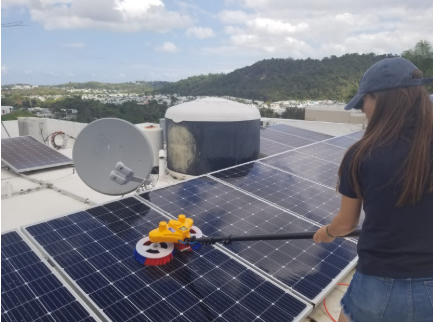While this task is generally classified as “non-electrical” maintenance, a more accurate label might be “quasi-electrical,” given the potential hazards involved.
Is Solar Panel Cleaning Safety the Next Frontier in EHS?
Carla Dawson Founder | Soilar.tech
In the solar industry, asset management has traditionally focused on the electrical aspects of maintaining installations. However, solar panel cleaning—a recurring and essential task throughout a solar installation’s operational lifespan—is often underestimated and oversimplified. While this task is generally classified as “non-electrical” maintenance, a more accurate label might be “quasi-electrical,” given the potential hazards involved. Insufficient inspections and job hazard analyses (JHAs) can expose workers to significant electrical risks, highlighting the need for greater attention to safety in this field.
Rethinking the Risks of Solar Panel Cleaning
Solar panels are frequently installed near high-risk electrical components, such as DC connectors, combiner boxes, and inverters. Cleaning methods typically involve water and brushes, often used with specialized machinery, which means workers are regularly exposed to wet panels and surfaces. This raises a critical question: can a wet, damaged electrical connection create a hazardous situation for cleaners?
Real-Life Hazard Scenarios
Scenario 1: A cleaner operates a water-spraying robot on a metal roof near damaged wiring or broken glass.

Scenario 2: A technician uses a conductive water-fed pole on a wet concrete rooftop without wearing dielectric gloves or boots.

A Growing Emphasis on Safety
Recognizing the unique challenges in this field, industry organizations are beginning to address solar panel cleaning safety. In 2024, the North American Board of Certified Energy Practitioners® (NABCEP®) introduced courses focused on this topic, offering certification credits for professionals involved in commissioning, installation, and design.
New Courses:
-
Solar Panel Cleaning Safety (2 credits)
-
Solar Panel Cleaning Safety for Residential Installations (4 credits)
-
Solar Panel Cleaning Safety for Commercial and Utility-Scale Solar Installations (9 credits)
Additionally, the Solar Energy Industries Association (SEIA) has integrated cleaning safety concepts into its committees, while the American Society for Testing and Materials (ASTM) is developing resources like testing protocols for cleaning robots and a comprehensive safety guide.
Expert Insights and Industry Gaps
Patrick Dennis Reeves, a certified PV electrician from New Jersey, describes solar panel cleaning safety as an emerging yet crucial discipline. He stresses the importance of thorough site inspections and hazard documentation before beginning any cleaning job.
Chris Vergin, President of SPCFonline.com, highlights a lack of built-in safety features in current cleaning equipment. "Manufacturers need to prioritize worker safety by designing tools like non-conductive, voltage-tested water-fed poles," Vergin says.
Key Risks for Solar Panel Cleaners
Non-Electrical Hazards:
-
Accessibility challenges
-
Falls and falling objects
-
Chemical exposure
-
Ergonomic stress
-
Weather-related risks
-
Wildlife interactions
Electrical and Fire Hazards:
-
Ground Faults: Caused by damaged insulation or loose connections.
-
Short Circuits: Resulting from direct contact between conductors.
-
Arc Faults: Electrical currents jumping between conductors, often due to corroded or damaged wires, pinched insulation, or foreign objects.
-
Other Risks:
-
Leakage currents
-
Equipment overheating or failure
-
Fire incidents
Building a Safer Future
To improve safety for solar panel cleaners, the following measures are essential:
-
Education: Providing comprehensive training on hazards and best practices.
-
Tailored JHAs: Developing site-specific job hazard analyses.
-
Standards and Protocols: Adopting industry-approved guidelines.
-
Innovative Tools: Employing safer, advanced cleaning equipment.
-
Classifying and Addressing Hazards
Safety risks can be categorized based on:
-
General job hazards.
-
The type of solar installation and site conditions.
-
Cleaning methods and tools used.
By understanding these factors, risks can be mitigated through better equipment, refined methodologies, and adherence to safety protocols.

The Path Forward for Solar O&M Technicians
Environmental, health, and safety (EHS) practices are common among solar installers but are still underdeveloped for operations and maintenance (O&M) technicians. Organizations like ASTM, NABCEP, and SEIA are taking steps to close this gap, paving the way for a safer and more sustainable solar industry.

Carla Dawson is a leader in solar panel cleaning safety, technology, and quality. She is an advisor to SEIA, NABCEP, SPCFonline.com, and ASTM and serves as VP of Product Development at Sol Clarity. With a background in industrial and systems engineering, Dawson has extensive experience in B2B technology product management.
The content & opinions in this article are the author’s and do not necessarily represent the views of AltEnergyMag
Comments (0)
This post does not have any comments. Be the first to leave a comment below.
Featured Product

